情态动词的基本用法归纳
常见的情态动词及其用法

常见的情态动词及其用法
常见的情态动词有 can,could,will,would,should,may,might 和 must。
以下是每一个情态动词的主要用法:
1. can(could):表示能力和可能性,一般在肯定句中使用。
例如:
- I can swim.
- Can you run fast?
2. will(would):表示意志、愿望和习惯,一般在肯定句中使用。
例如:
- I will go to school tomorrow.
- I would play basketball if I had time.
3. should:表示建议和义务,一般在肯定句和疑问句中使用。
例如:
- You should wear a coat.
- Should we go to the movies?
4. may(might):表示许可和可能性,一般在肯定句和疑问句中使用。
例如:
- You may go now.
- Might you give me a ride to the airport?
5. must:表示义务和必要,一般在肯定句和疑问句中使用。
例如:
- You must clean your room.
- Must we finish this project before Friday?。
情态动词的用法
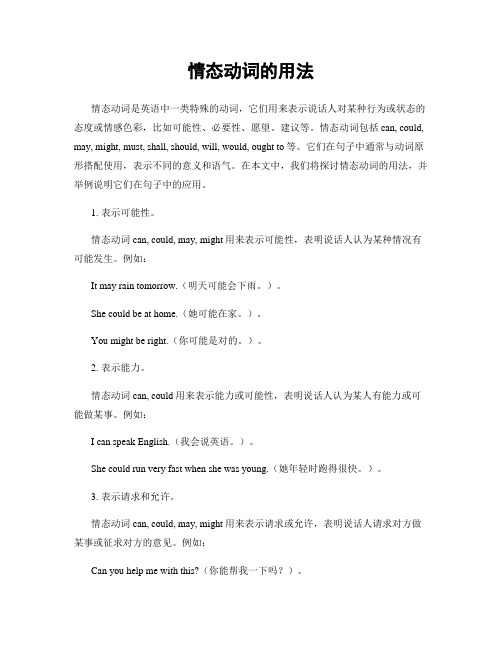
情态动词的用法情态动词是英语中一类特殊的动词,它们用来表示说话人对某种行为或状态的态度或情感色彩,比如可能性、必要性、愿望、建议等。
情态动词包括can, could, may, might, must, shall, should, will, would, ought to等。
它们在句子中通常与动词原形搭配使用,表示不同的意义和语气。
在本文中,我们将探讨情态动词的用法,并举例说明它们在句子中的应用。
1. 表示可能性。
情态动词can, could, may, might用来表示可能性,表明说话人认为某种情况有可能发生。
例如:It may rain tomorrow.(明天可能会下雨。
)。
She could be at home.(她可能在家。
)。
You might be right.(你可能是对的。
)。
2. 表示能力。
情态动词can, could用来表示能力或可能性,表明说话人认为某人有能力或可能做某事。
例如:I can speak English.(我会说英语。
)。
She could run very fast when she was young.(她年轻时跑得很快。
)。
3. 表示请求和允许。
情态动词can, could, may, might用来表示请求或允许,表明说话人请求对方做某事或征求对方的意见。
例如:Can you help me with this?(你能帮我一下吗?)。
Could I use your pen?(我可以用一下你的笔吗?)。
May I come in?(我可以进来吗?)。
4. 表示必要性。
情态动词must, should, ought to用来表示必要性或建议,表明说话人认为某种行为是必要的或值得做的。
例如:You must finish your homework before you go out to play.(你必须在出去玩之前完成作业。
)。
You should apologize to her.(你应该向她道歉。
情态动词用法归纳总结
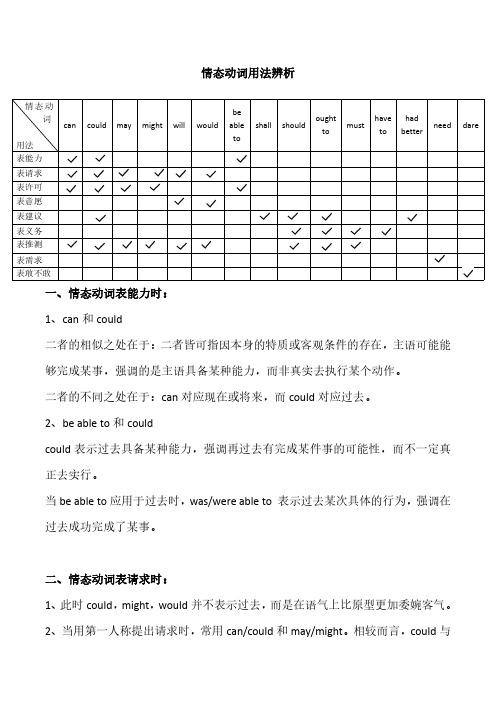
情态动词用法辨析情态动词用法can could may might will would be able to shall should ought to must have to had better need dare表能力表请求表许可表意愿表建议表义务表推测表需求表敢不敢一、情态动词表能力时:1、can 和could二者的相似之处在于:二者皆可指因本身的特质或客观条件的存在,主语可能能够完成某事,强调的是主语具备某种能力,而非真实去执行某个动作。
二者的不同之处在于:can 对应现在或将来,而could 对应过去。
2、be able to 和couldcould 表示过去具备某种能力,强调再过去有完成某件事的可能性,而不一定真正去实行。
当be able to 应用于过去时,was/were able to 表示过去某次具体的行为,强调在过去成功完成了某事。
二、情态动词表请求时:1、此时could ,might ,would 并不表示过去,而是在语气上比原型更加委婉客气。
2、当用第一人称提出请求时,常用can/could 和may/might 。
相较而言,could 与may在表请求的问句中出现的频率最高;might表发请求的语气最为委婉客气,因此反而很少见;而can则常用于熟人间的对话中。
语气强度:can>could/might>might3、当用第二人称提出请求时,常用can/could和will/would。
其中could和would 表达请求的语气更委婉客气;而can与will则常用于熟人对话中。
语气强度:can/will>could/would三、情态动词表许可时:1、与表请求不同,will/would不论前接第几人称,都表示主语本身的意愿,无需得到他人的“许可”,所以will/would不可以用于表请求的句中。
2、can和may二者都可以表示对现在或将来动作的许可,其中can的使用频率更高。
情态动词的基本用法归纳
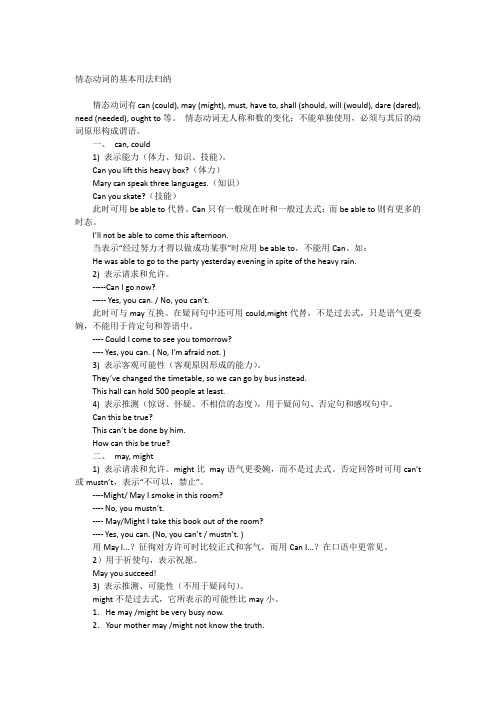
情态动词的基本用法归纳情态动词有can (could), may (might), must, have to, shall (should, will (would), dare (dared), need (needed), ought to等。
情态动词无人称和数的变化;不能单独使用,必须与其后的动词原形构成谓语。
一、can, could1) 表示能力(体力、知识、技能)。
Can you lift this heavy box?(体力)Mary can speak three languages.(知识)Can you skate?(技能)此时可用be able to代替。
Can只有一般现在时和一般过去式;而be able to则有更多的时态。
I’ll not be able to come this afternoon.当表示“经过努力才得以做成功某事”时应用be able to,不能用Can。
如:He was able to go to the party yesterday evening in spite of the heavy rain.2) 表示请求和允许。
-----Can I go now?----- Yes, you can. / No, you can’t.此时可与may互换。
在疑问句中还可用could,might代替,不是过去式,只是语气更委婉,不能用于肯定句和答语中。
---- Could I come to see you tomorrow?---- Yes, you can. ( No, I’m afraid not. )3) 表示客观可能性(客观原因形成的能力)。
T hey’ve changed the timetable, so we can go by bus instead.This hall can hold 500 people at least.4) 表示推测(惊讶、怀疑、不相信的态度),用于疑问句、否定句和感叹句中。
情态动词的基本用法
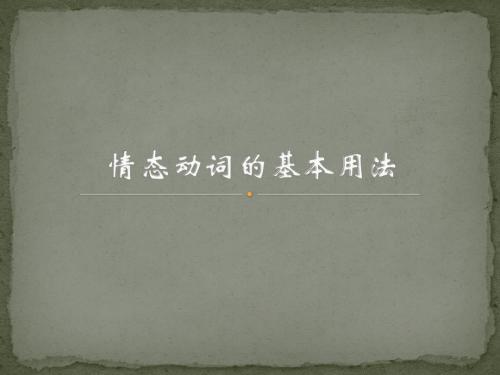
1. can的基本用法: ⑴ 表示体力或智力上的能力,即“能够,会”,可与be able to转换。 例:He can speak English. = He is able to speak English. —Can you play basketball? — No, I can’t. 如果表示将来具备的能力,要用will be able to。 例:If I have a good sleep, I will be able to do the problem. ⑵ 表示许可,主要用于口语,书面语一般用may。 例:—Can we go home now, please? — No, you can’t. You can only smoke in this room. You can’t keep the library books for more than a month.
1. can的基本用法: ⑶ 表示“可能”,与may同义,但一般用在疑问句中。 例:What can he possibly want? 在否定句中,否定形式can’t表示推测“不大可能”。 例:Anybody can make mistakes. The news can’t be true. 与第一、二人称连用时,还可以就可能的解决问题的方式或可能的行为 提出建议。在这里,也可用could使语气婉转。 例:Can / Could we meet again next week? 下周我们可以再见面吗? —What shall we do? 我们怎么办呢? — We can / could try asking Lucy for help. ——我们可以请露茜帮忙试试 看。 You can / could help me with the cooking. 你可以帮我做饭。
情态动词用法归纳(全)
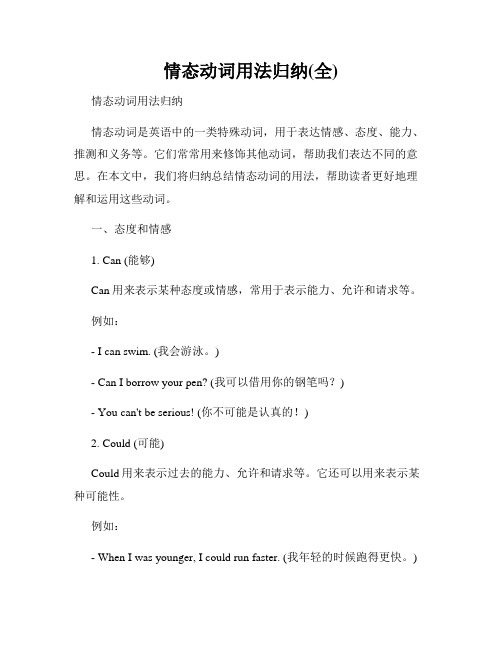
情态动词用法归纳(全)情态动词用法归纳情态动词是英语中的一类特殊动词,用于表达情感、态度、能力、推测和义务等。
它们常常用来修饰其他动词,帮助我们表达不同的意思。
在本文中,我们将归纳总结情态动词的用法,帮助读者更好地理解和运用这些动词。
一、态度和情感1. Can (能够)Can用来表示某种态度或情感,常用于表示能力、允许和请求等。
例如:- I can swim. (我会游泳。
)- Can I borrow your pen? (我可以借用你的钢笔吗?)- You can't be serious! (你不可能是认真的!)2. Could (可能)Could用来表示过去的能力、允许和请求等。
它还可以用来表示某种可能性。
例如:- When I was younger, I could run faster. (我年轻的时候跑得更快。
)- Could I ask you a question? (我可以问你一个问题吗?)- It could rain later, so bring an umbrella. (今天后面可能会下雨,所以带上雨伞。
)3. May (可能)May常表示许可、请求和推测等。
它还可以用来表示某种可能性或希望。
例如:- May I use your phone? (我可以用一下你的手机吗?)- It may rain tomorrow. (明天可能会下雨。
)- They may arrive late. (他们可能会迟到。
)4. Might (可能)Might与may的用法类似,但表示的可能性稍微低一些。
例如:- She might be busy. (她可能很忙。
)- I might go to the party, but I'm not sure yet. (我可能会去参加派对,但我还不确定。
)二、能力和推测1. Must (必须)Must用来表示强烈的推断或必要性。
情态动词的用法
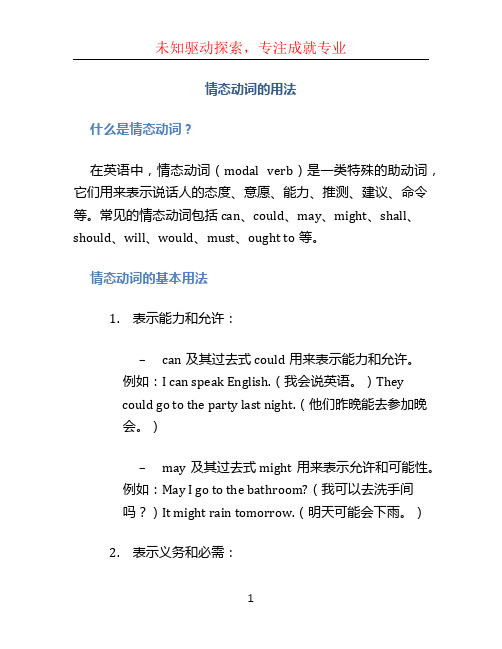
情态动词的用法什么是情态动词?在英语中,情态动词(modal verb)是一类特殊的助动词,它们用来表示说话人的态度、意愿、能力、推测、建议、命令等。
常见的情态动词包括can、could、may、might、shall、should、will、would、must、ought to等。
情态动词的基本用法1.表示能力和允许:–can及其过去式could用来表示能力和允许。
例如:I can speak English.(我会说英语。
)Theycould go to the party last night.(他们昨晚能去参加晚会。
)–may及其过去式might用来表示允许和可能性。
例如:May I go to the bathroom?(我可以去洗手间吗?)It might rain tomorrow.(明天可能会下雨。
)2.表示义务和必需:–must用来表示义务和必需。
例如:You must finish your homework before playing games.(你必须在玩游戏之前完成作业。
)–should用来表示应该和建议。
例如:She should eat more vegetables for her health.(她应该多吃蔬菜保护健康。
)3.表示推测和肯定:–will用来表示未来意愿和不可避免的行为。
例如:I will help you with your presentation.(我会帮你做演讲。
)–would用来表示假设和委婉表达。
例如:If I had more time, I would travel around the world.(如果我有更多时间,我会环游世界。
)情态动词的用法注意事项1.情态动词后接不带to的原形动词,即不加动词的第三人称单数-s形式。
例如:He can swim well.(他游泳游得很好。
)They should study hard.(他们应该努力学习。
情态动词的用法
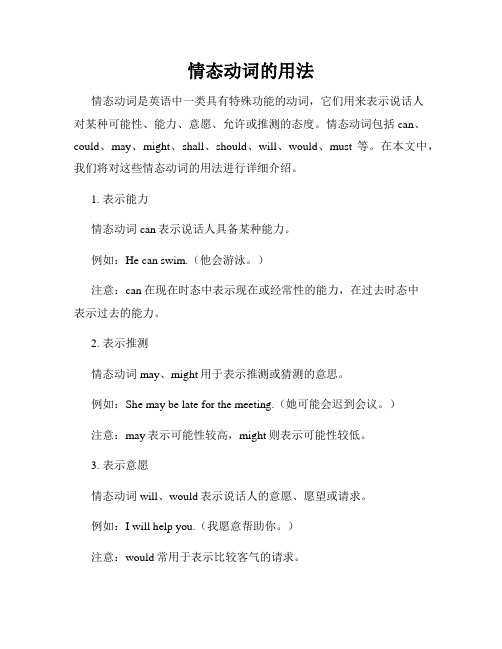
情态动词的用法情态动词是英语中一类具有特殊功能的动词,它们用来表示说话人对某种可能性、能力、意愿、允许或推测的态度。
情态动词包括can、could、may、might、shall、should、will、would、must等。
在本文中,我们将对这些情态动词的用法进行详细介绍。
1. 表示能力情态动词can表示说话人具备某种能力。
例如:He can swim.(他会游泳。
)注意:can在现在时态中表示现在或经常性的能力,在过去时态中表示过去的能力。
2. 表示推测情态动词may、might用于表示推测或猜测的意思。
例如:She may be late for the meeting.(她可能会迟到会议。
)注意:may表示可能性较高,might则表示可能性较低。
3. 表示意愿情态动词will、would表示说话人的意愿、愿望或请求。
例如:I will help you.(我愿意帮助你。
)注意:would常用于表示比较客气的请求。
4. 表示推测的过去情态动词must常用于表示对过去情况的推测或肯定。
例如:He must have missed the bus.(他肯定错过了公交车。
)注意:must用于表示对过去情况的肯定,而might用于表示对过去情况的推测。
5. 表示义务或必要性情态动词must表示对义务、必要性或确定性的肯定。
例如:You must finish your homework.(你必须完成作业。
)6. 表示建议或应该情态动词should表示建议或应该。
例如:You should go to bed early.(你应该早点睡觉。
)注意:should还可以表示对过去情况的推测,例如:He should have arrived by now.(他现在应该已经到达了。
)7. 表示允许或许可情态动词can与may可以用于表示许可或允许。
例如:Can I borrow your pen?(我可以借你的钢笔吗?)8. 表示可能性情态动词could用于表示可能性。
情态动词用法归纳(全)

四、 dare, need
3) dare和 need作实义动词用时, 有人称、时态和数的变化。 在肯定句中,dare后面常接带to的不定式。在疑问句和否 认句中,dare后面可接带to或不带to的不定式。而need后 面只能接带to的不定式。
1. I dare to swim across this river.
----Can it be our teacher? 那个人有可能是我们老师吗?
----No, it can’t be our teacher. He is on a visit to the Great Wall. 不可能。咱们老师正在游览长城精呢品P。PT
例 --- I think Miss Gao must be in the library. She said she would go there. ----- No. She __ be there, I have just been there. A.can’t B.mustn’t C.needn’t D.wouldn’t
精品PPT
六、 will, would
• 3) would表示过去反复发生的动作或某种倾向。would表 示过去习惯时比used to正式,且没有“现已无此习惯〞的 含义。
• 1. During the vacation, he would visit me every other day.
• 2. The wound would not heal.
• 4) 表示估计和猜测。
• It would be about ten o’clock when she left home.
精品PPT
七、should, ought to
1) should, ought to表示“应该〞,ought to表示义务或责任, 比should语气重。
情态动词的用法归纳
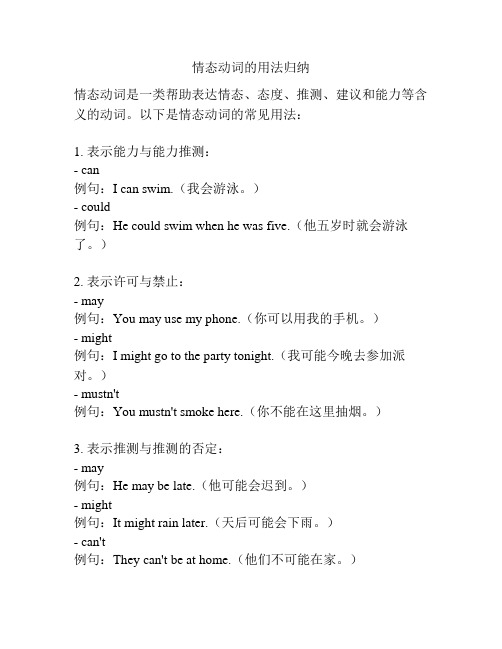
情态动词的用法归纳情态动词是一类帮助表达情态、态度、推测、建议和能力等含义的动词。
以下是情态动词的常见用法:1. 表示能力与能力推测:- can例句:I can swim.(我会游泳。
)- could例句:He could swim when he was five.(他五岁时就会游泳了。
)2. 表示许可与禁止:- may例句:You may use my phone.(你可以用我的手机。
)- might例句:I might go to the party tonight.(我可能今晚去参加派对。
)- mustn't例句:You mustn't smoke here.(你不能在这里抽烟。
)3. 表示推测与推测的否定:- may例句:He may be late.(他可能会迟到。
)- might例句:It might rain later.(天后可能会下雨。
)- can't例句:They can't be at home.(他们不可能在家。
)4. 表示义务与责任:- must例句:We must finish our homework.(我们必须完成作业。
)- have to例句:I have to go to work early tomorrow.(我明天必须早点去上班。
)5. 表示愿望与建议:- should例句:You should exercise regularly.(你应该经常锻炼。
)- ought to例句:They ought to help others.(他们应该帮助别人。
)6. 表示推荐与要求:- would like例句:I would like to have a cup of tea.(我想要一杯茶。
)- need例句:You need to finish this report by tomorrow.(你需要在明天之前完成这份报告。
情态动词用法总结归纳

情态动词用法总结归纳情态动词是英语中的一个重要词类,其特点在于不具备时态和人称变化,通常用于表达语气、态度、能力、可能性等方面。
常用的情态动词包括can、could、may、might、will、would、shall、should、must等。
本文将就情态动词的用法进行总结归纳,以帮助读者更好地掌握这一重要语法点。
1. 表示能力或可能性情态动词can和could常用于表示某人有能力做某事,如“I can speak English fluently.”(我能够流利地说英语。
);“He could run 10 kilometers without stopping.”(他可以不停顿地跑10公里。
)may和might则表示可能性,如“It may rain tomorrow.”(明天可能会下雨。
);“I might go to the party if I finishmy work on time.”(如果我按时完成工作,我可能会去参加派对。
)2. 表示请求、建议或命令情态动词will和would可用于表示请求、建议或命令,如“Will you help me with my homework?”(你能帮我完成家庭作业吗?);“Would you like to have a cup of tea?”(你想喝杯茶吗?)应用到疑问句中时,表达委婉的请求,比一般的陈述性语句更容易得到他人的配合。
3. 表示义务或必须性情态动词must和should则表示义务或必须性,如“I mustfinish my project by Friday.”(我必须在周五完成我的项目。
);“You should eat more vegetables.”(你应该多吃蔬菜。
)值得注意的是,must常用于表示说话人的主观判断或要求,而should则表示客观上的合理建议或道义上的规范。
4. 表示推测或推论情态动词may、might和could亦可用于表示推测或推论,如“It may snow in the evening.”(晚上可能会下雪。
情态动词的用法总结及例句解析
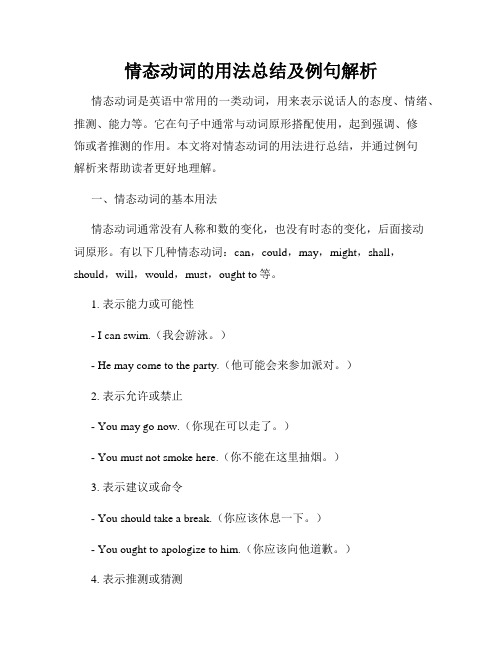
情态动词的用法总结及例句解析情态动词是英语中常用的一类动词,用来表示说话人的态度、情绪、推测、能力等。
它在句子中通常与动词原形搭配使用,起到强调、修饰或者推测的作用。
本文将对情态动词的用法进行总结,并通过例句解析来帮助读者更好地理解。
一、情态动词的基本用法情态动词通常没有人称和数的变化,也没有时态的变化,后面接动词原形。
有以下几种情态动词:can,could,may,might,shall,should,will,would,must,ought to等。
1. 表示能力或可能性- I can swim.(我会游泳。
)- He may come to the party.(他可能会来参加派对。
)2. 表示允许或禁止- You may go now.(你现在可以走了。
)- You must not smoke here.(你不能在这里抽烟。
)3. 表示建议或命令- You should take a break.(你应该休息一下。
)- You ought to apologize to him.(你应该向他道歉。
)4. 表示推测或猜测- He could be there.(他可能在那里。
)- It might rain tomorrow.(明天可能会下雨。
)5. 表示义务或必须- We must finish the project on time.(我们必须按时完成这个项目。
)- You ought to help him.(你应该帮助他。
)二、情态动词的细分用法除了以上的基本用法外,情态动词还有一些特殊的用法,需要注意其具体含义和用法。
1. can 和 could- 表示能力和技能:I can play the piano.(我会弹钢琴。
)- 表示请求或许可:Can I use your computer?(我可以用你的电脑吗?)- could 还可以用来表示过去的能力或许可:When I was young, I could run very fast.(小时候,我跑得很快。
情态动词的用法总结

情态动词的用法总结情态动词是英语词汇中重要的一部分,它们的一般用法在语言学习者之间广为人知。
然而,情态动词的不同用法很少被广泛讨论。
本文将通过介绍情态动词众多用法,以及它们存在的不同场合,让读者对它们有更全面的认识和理解,从而收获更丰富的知识。
情态动词是一类特殊的动词,它们不表示动作,而是表示说话人的态度和意图。
它们通常用来表示说话人的认可或态度,如“能”、“必须”、“可以”等。
情态动词的用法,可以归纳为以下几种:(1)情态动词+动词原形:情态动词表示能力、规定或义务,动词原形表示其后的动作。
例如:I can speak English.(我会说英语。
)(2)情态动词+be动词:情态动词表示可能性、猜测,be动词表示其后的动作。
例如:She must be in the office.(她一定在办公室。
)(3)情态动词+have +过去分词:情态动词表示虚拟情况,过去分词表示过去发生的情况。
例如:He should have finished his work.(他本应该完成他的工作。
)(4)情态动词+have +动词的原形:情态动词表示建议或命令,动词的原形表示后面的动作。
例如:We must have a meeting.(我们必须开会。
)除了上面介绍的情态动词常用结构外,还有其他用法也需要注意。
例如,情态动词还可以用来表示自己认为有可能发生的事情,即“可能”。
当情态动词用来表示可能时,可以用“might”、“could”、“may”等表达。
例如:He might be able to help us.(他可能可以帮助我们。
)此外还可以使用“should”表示建议,它的否定形式“should not”可以表示禁止或劝阻。
例如:You should not go out after dark.(你晚上不应该出去。
)情态动词还可以用来表示让步,这时使用的情态动词一般是“could”或“would”。
英语情态动词的基本用法
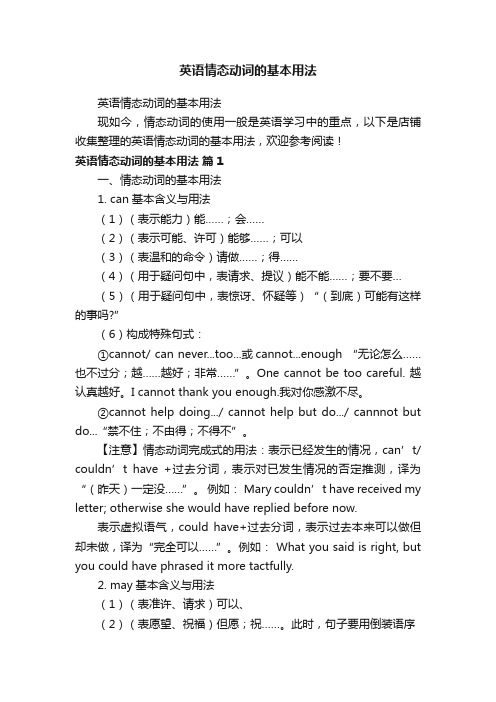
英语情态动词的基本用法英语情态动词的基本用法现如今,情态动词的使用一般是英语学习中的重点,以下是店铺收集整理的英语情态动词的基本用法,欢迎参考阅读!英语情态动词的基本用法篇1一、情态动词的基本用法1. can基本含义与用法(1)(表示能力)能……;会……(2)(表示可能、许可)能够……;可以(3)(表温和的命令)请做……;得……(4)(用于疑问句中,表请求、提议)能不能……;要不要…(5)(用于疑问句中,表惊讶、怀疑等)“(到底)可能有这样的事吗?”(6)构成特殊句式:①cannot/ can never...too...或cannot...enough “无论怎么……也不过分;越……越好;非常……”。
One cannot be too careful. 越认真越好。
I cannot thank you enough.我对你感激不尽。
②cannot help doing.../ cannot help but do.../ c annnot but do...“禁不住;不由得;不得不”。
【注意】情态动词完成式的用法:表示已经发生的情况,can’t/ couldn’t have +过去分词,表示对已发生情况的否定推测,译为“(昨天)一定没……”。
例如:Mary couldn’t have received my letter; otherwise she would have replied before now.表示虚拟语气,could have+过去分词,表示过去本来可以做但却未做,译为“完全可以……”。
例如: What you said is right, but you could have phrased it more tactfully.2. may基本含义与用法(1)(表准许、请求)可以、(2)(表愿望、祝福)但愿;祝……。
此时,句子要用倒装语序(3)(用于目的状语从句中)为了;为了能够(4)(用于让步状语从句中)即使;无论(5)构成句型:may/ might as well do sth. “还是做某事的好;不妨去做某事”【注意】情态动词完成式的用法:表示已经发生的情况,may/ might have +过去分词,表示对已发生的事情做不肯定、可能性很小的推测,或事实上根本没发生,译为“也许……”。
情态动词的用法归纳终极版
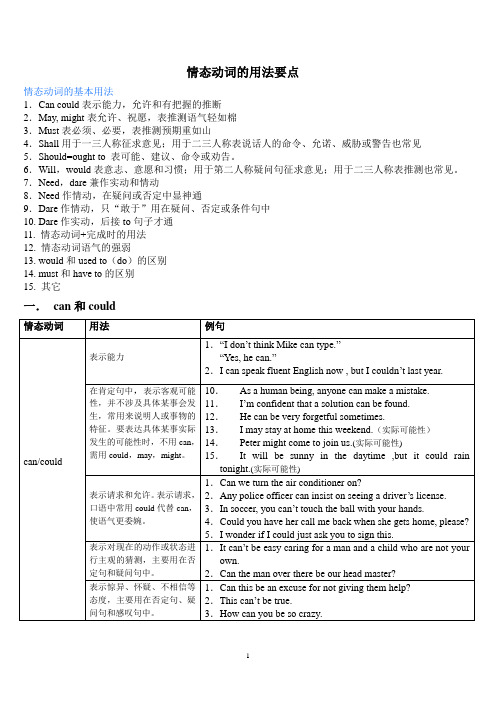
情态动词的用法要点情态动词的基本用法1.Can could表示能力,允许和有把握的推断2.May, might表允许、祝愿,表推测语气轻如棉3.Must表必须、必要,表推测预期重如山4.Shall用于一三人称征求意见;用于二三人称表说话人的命令、允诺、威胁或警告也常见5.Should=ought to 表可能、建议、命令或劝告。
6.Will,would表意志、意愿和习惯;用于第二人称疑问句征求意见;用于二三人称表推测也常见。
7.Need,dare兼作实动和情动8.Need作情动,在疑问或否定中显神通9.Dare作情动,只“敢于”用在疑问、否定或条件句中10. Dare作实动,后接to句子才通11. 情态动词+完成时的用法12. 情态动词语气的强弱13. would和used to(do)的区别14. must和have to的区别15. 其它一.can和could特别说明:(1)could用来表示请求时,语气委婉,主要用于疑问句,不能用于肯定句,答语应用can(即:could不能用于现在时态的简略答语中)。
如:——Could I use your dictionary?——Yes, you can.(否定回答可用:No, I’m afraid not.)(2)can和be able to辨析can(could)和be able to都可以表示能力,意思上没有区别。
但can只有现在式和过去式,而be able to则有更多的形式。
如:I’ve always wanted to able to speak fluent English.Those bags look really heavy, are you sure you’ll be able to carry them on your own?但是,表示在过去某时的某一场合经过一番努力,终于做成了某事,通常不用could,而用was/were able to来表示。
初中英语情态动词详细用法归纳(含练习及答案)
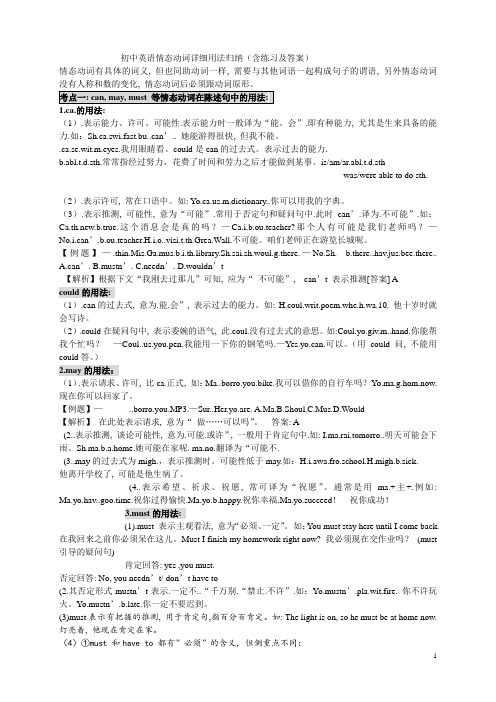
初中英语情态动词详细用法归纳(含练习及答案)情态动词有具体的词义, 但也同助动词一样, 需要与其他词语一起构成句子的谓语, 另外情态动词没有人称和数的变化, 情态动词后必须跟动词原形。
1.ca.的用法:(1).表示能力、许可、可能性.表示能力时一般译为“能、会”.即有种能力, 尤其是生来具备的能力.如:Sh.ca.swi.fast.bu..can’.. 她能游得很快, 但我不能。
.ca.se.wit.m.eyes.我用眼睛看。
could是can的过去式。
表示过去的能力.b.abl.t.d.sth.常常指经过努力,花费了时间和劳力之后才能做到某事。
is/am/ar.abl.t.d.sthwas/were able to do sth.(2).表示许可, 常在口语中。
如: .m.dictionary..你可以用我的字典。
(3).表示推测, 可能性, 意为“可能”.常用于否定句和疑问句中.此时can’.译为.不可能”.如:Ca.th.new.b.true.这个消息会是真的吗?—Ca.i.b.ou.teacher?那个人有可能是我们老师吗?—No.i.can’.b.ou.teacher.H.i.o..visi.t.th.Grea.Wall.不可能。
咱们老师正在游览长城呢。
【例题】—.thin.Mis.Ga.mus.b.i.th.library.Sh.sai.sh.woul.g.there.—No.Sh.__b.there..hav.jus.bee.there..A.can’.B.mustn’.C.needn’.D.wouldn’t【解析】根据下文“我刚去过那儿”可知, 应为“不可能”, can’t 表示推测[答案] Acould的用法:(1).can的过去式, 意为.能.会”, 表示过去的能力。
如: H.coul.writ.poem.whe.h.wa.10. 他十岁时就会写诗。
(2).could在疑问句中, 表示委婉的语气, 此.coul.没有过去式的意思。
情态动词的基本用法
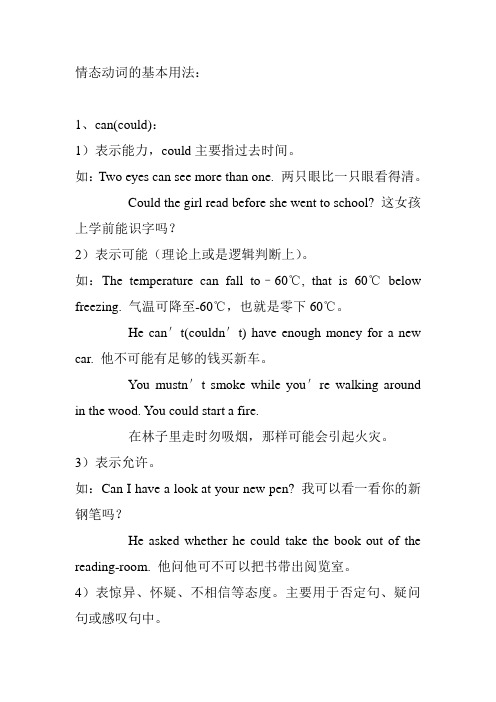
情态动词的基本用法:1、can(could):1)表示能力,could主要指过去时间。
如:Two eyes can see more than one. 两只眼比一只眼看得清。
Could the girl read before she went to school? 这女孩上学前能识字吗?2)表示可能(理论上或是逻辑判断上)。
如:The temperature can fall to–60℃, that is 60℃below freezing. 气温可降至-60℃,也就是零下60℃。
He can′t(couldn′t) have enough money for a new car. 他不可能有足够的钱买新车。
You mustn′t smoke while you′re walking around in the wood. You could start a fire.在林子里走时勿吸烟,那样可能会引起火灾。
3)表示允许。
如:Can I have a look at your new pen? 我可以看一看你的新钢笔吗?He asked whether he could take the book out of the reading-room. 他问他可不可以把书带出阅览室。
4)表惊异、怀疑、不相信等态度。
主要用于否定句、疑问句或感叹句中。
如:Where can(could) they have gone to? 他们会去哪儿了呢?He can′t(couldn′t) be over sixty. 他不可能超过六十岁。
How can you be so careless? 你怎么这么粗心?5)比较委婉客气地提出问题或陈述看法。
如:Can(Could) you lend me a hand? 帮我一把好吗?I′m afraid we couldn′t give you an answer today. 恐怕我们今天不能给你答复。
情态动词的用法总结
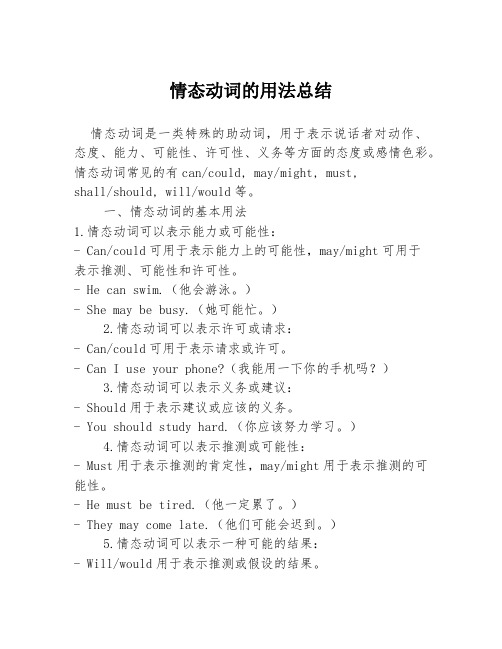
情态动词的用法总结情态动词是一类特殊的助动词,用于表示说话者对动作、态度、能力、可能性、许可性、义务等方面的态度或感情色彩。
情态动词常见的有can/could, may/might, must,shall/should, will/would等。
一、情态动词的基本用法1.情态动词可以表示能力或可能性:- Can/could可用于表示能力上的可能性,may/might可用于表示推测、可能性和许可性。
- He can swim.(他会游泳。
)- She may be busy.(她可能忙。
)2.情态动词可以表示许可或请求:- Can/could可用于表示请求或许可。
- Can I use your phone?(我能用一下你的手机吗?)3.情态动词可以表示义务或建议:- Should用于表示建议或应该的义务。
- You should study hard.(你应该努力学习。
)4.情态动词可以表示推测或可能性:- Must用于表示推测的肯定性,may/might用于表示推测的可能性。
- He must be tired.(他一定累了。
)- They may come late.(他们可能会迟到。
)5.情态动词可以表示一种可能的结果:- Will/would用于表示推测或假设的结果。
- If it rains, we will stay indoors.(如果下雨了,我们就呆在室内。
)二、情态动词的注意事项1.情态动词没有人称和数的变化,后面直接跟动词原形。
- He can play the piano.(他会弹钢琴。
)2.情态动词后面的动词一般用原形,表示动作和状态。
- I can swim.(我会游泳。
)- They should apologize.(他们应该道歉。
)3.情态动词用于疑问句时,直接将情态动词置于句首。
- Can you swim?(你会游泳吗?)4.情态动词用于否定句时,直接在情态动词前加"not"。
情态动词的用法归纳总结 小学英语情态动词的基本用法
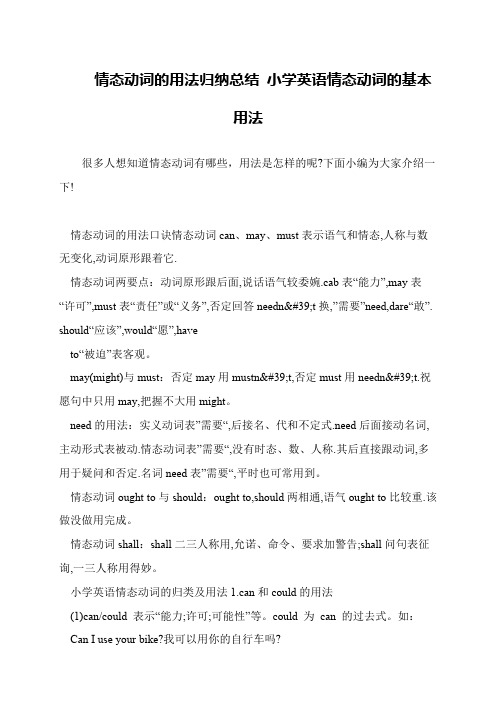
情态动词的用法归纳总结小学英语情态动词的基本
用法
很多人想知道情态动词有哪些,用法是怎样的呢?下面小编为大家介绍一下!
情态动词的用法口诀情态动词can、may、must表示语气和情态,人称与数无变化,动词原形跟着它.
情态动词两要点:动词原形跟后面,说话语气较委婉.cab表“能力”,may表“许可”,must表“责任”或“义务”,否定回答needn't换,”需要”need,dare“敢”. should“应该”,would“愿”,have
to“被迫”表客观。
may(might)与must:否定may用mustn't,否定must用needn't.祝愿句中只用may,把握不大用might。
need的用法:实义动词表”需要“,后接名、代和不定式.need后面接动名词,主动形式表被动.情态动词表”需要“,没有时态、数、人称.其后直接跟动词,多用于疑问和否定.名词need表”需要“,平时也可常用到。
情态动词ought to与should:ought to,should两相通,语气ought to比较重.该做没做用完成。
情态动词shall:shall二三人称用,允诺、命令、要求加警告;shall问句表征询,一三人称用得妙。
小学英语情态动词的归类及用法1.can和could的用法
(1)can/could 表示“能力;许可;可能性”等。
could 为can 的过去式。
如:
Can I use your bike?我可以用你的自行车吗?。
- 1、下载文档前请自行甄别文档内容的完整性,平台不提供额外的编辑、内容补充、找答案等附加服务。
- 2、"仅部分预览"的文档,不可在线预览部分如存在完整性等问题,可反馈申请退款(可完整预览的文档不适用该条件!)。
- 3、如文档侵犯您的权益,请联系客服反馈,我们会尽快为您处理(人工客服工作时间:9:00-18:30)。
~情态动词的基本用法归纳情态动词有can (could), may (might), must, have to, shall (should, will (would), dare (dared), need (needed), ought to等。
情态动词无人称和数的变化;不能单独使用,必须与其后的动词原形构成谓语。
一、 can, could1) 表示能力(体力、知识、技能)。
Can you lift this heavy box(体力)Mary can speak three languages.(知识)\Can you skate(技能)此时可用be able to代替。
Can只有一般现在时和一般过去式;而be able to则有更多的时态。
I’ll not be able to come this afternoon.当表示“经过努力才得以做成功某事”时应用be able to,不能用Can。
如:He was able to go to the party yesterday evening in spite of the heavy rain.2) 表示请求和允许。
-----Can I go now----- Yes, you can. / No, you can’t.%此时可与may互换。
在疑问句中还可用could,might代替,不是过去式,只是语气更委婉,不能用于肯定句和答语中。
---- Could I come to see you tomorrow---- Yes, you can. ( No, I’m afraid not. )3) 表示客观可能性(客观原因形成的能力)。
They’ve changed the timetable, so we can go by bus instead.This hall can hold 500 people at least.4) 表示推测(惊讶、怀疑、不相信的态度),用于疑问句、否定句和感叹句中。
Can this be true?This can’t be done by him.How can this be true二、 may, might1) 表示请求和允许。
might比 may语气更委婉,而不是过去式。
否定回答时可用can’t 或mustn’t,表示“不可以,禁止”。
----Might/ May I smoke in this room---- No, you mustn’t.---- May/Might I take this book out of the room---- Yes, you can. (No, you can’t / mustn’t. )》用May I...征徇对方许可时比较正式和客气,而用Can I...在口语中更常见。
2)用于祈使句,表示祝愿。
May you succeed!3) 表示推测、可能性(不用于疑问句)。
might不是过去式,它所表示的可能性比may小。
1.He may /might be very busy now.2.Your mother may /might not know the truth.三、 must, have to:1) 表示必须、必要。
You must come in time.在回答引出的问句时,如果是否定的,不能用mustn’t(禁止,不准),而用needn’t, don’t have to(不必).---- Must we hand in our exercise books today---- Yes, you must.---- No, you don’t have to / you needn’t.2) must是说话人的主观看法,而have to则强调客观需要。
Must只有一般现在时, have to 有更多的时态形式。
1.he play isn’t interesting, I real ly must go now.)2. I had to work when I was your age.3) 表示推测、可能性(只用于肯定的陈述句)1.You’re Tom’s good friend, so you must know what he likes best.2. Your mother must be waiting for you now.四、 dare, need1) dare作情态动词用时, 常用于疑问句、否定句和条件从句中, 过去式形式为dared。
1.How dare you say I’m unfair2.He daren’t speak English before such a crowd, dare he;3. If we dared not go there that day,we couldn’t get the beautiful flowers.2) need 作情态动词用时, 常用于疑问句、否定句。
在肯定句中一般用must, have to, ought to, should代替。
1.You needn’t come so early.2. ---- Need I finish the work today---- Yes, you must. / No, you needn’t.3) dare和 need作实义动词用时,有人称、时态和数的变化。
在肯定句中,dare后面常接带to的不定式。
在疑问句和否定句中,dare后面可接带to或不带to的不定式。
而need后面只能接带to的不定式。
1. I dare to swim across this river.2. He doesn’t dare (to) answer.#五、 shall, should1) shall 用于第一人称,征求对方的意见。
What shall we do this evening2) shall 用于第二、三人称,表示说话人给对方的命令、警告、允诺或威胁。
1. You shall fail if you don’t work hard.(警告)2. He shall have the book when I finish it.(允诺)3. He shall be punished.(威胁)六、 will, would-1) 表示请求、建议等,would更委婉。
Will / Would you pass me the ball, please2) 表示意志、愿望和决心。
1. I will never do that again.2. They asked him if he would go abroad.3) would表示过去反复发生的动作或某种倾向。
would表示过去习惯时比used to正式,且没有“现已无此习惯”的含义。
1. During the vacation, he would visit me every other day.2. The wound would not heal.>4) 表示估计和猜想。
It would be about ten o’clock when she left home.七、 should, ought to1) should, ought to表示“应该”,ought to表示义务或责任,比should语气重。
1. I should help her because she is in trouble.2. You ought to take care of the baby.2) 表示劝告、建议和命令。
should, ought to可通用,但在疑问句中常用should。
1. You should / ought to go to class right away.]2. Should I open the window3) 表示推测should , ought to (客观推测), must(主观推测)。
must be home by now. (断定他已到家)ought to/should be home by now.(不太肯定)3. This is where the oil must be.(直爽)4. This is where the oil ought to/should be.(含蓄)八、情态动词+不定式完成式(have done)~1) can / could + have done在肯定句中表示“本来可以做而实际上能做某事”,是虚拟语气;在疑问句或否定句中表示对过去行为的怀疑或不肯定, 表示推测。
1. You could have done better, but you didn’t try your best. (虚拟语气)2. He can’t have been to that town.(推测)3. Can he have got the book(推测)2) may / might +不定式完成式(have done)表示对过去行为的推测。
不能用于疑问句中,没有虚拟语气的用法。
Might所表示的可能性比may小。
1. He may not have finished the work .2. If we had taken the other road, we might have arrived earlier.,3)must +不定式完成式(have done)用于肯定句中,表示对过去行为的推测。
意为“一定、想必”。
其疑问、否定形式用can,can’t代替。
参看1) can / could + have done表示推测。
1. You must have seen the film Titanic.2. He must have been to Shanghai.4)should +不定式完成式(have done)用于肯定句中,表示对过去行为的推测。
He should have finished the work by now。
表示“本应该做而实际上没有做某事”,其否定式表示某种行为本不该发生却发生了。
可以与ought to +不定式完成式(have done)互换。
1. You ought to / should have helped him. (but you didn’t.)2. She shouldn’t have taken away my measuring tape, for I wanted to use it.5) needn’t +不定式完成式(have done)表示“本来不必做而实际上做了某事”。
